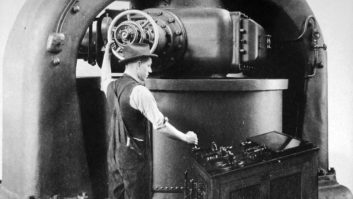The Best 10 Years of Radio magazine
Nov 1, 2003 12:00 PM
The Best 10 Years of Radio
2002 and 2003
Over the past 10 years, radio has grown and evolved. Instead of carts and magnetic tape, digital storage and delivery is the norm. As we continue our retrospective of the past 10 years of Radio magazine, we look at the years 2002 and 2003. Since our first issue in January 1994, the radio industry has changed in many ways. In our final installment, we give you the last pieces of the highlights that have made our industry what it is today. Through it all, Radio magazine has been there. We thank you, our readers, for your ongoing support. Our first 10 years were great; the next 10 years will be even better.

Timeline
2002
- The FCC seeks comments on the NRSC FM IBOC reports.
- The FCC rewrites the EEO rules again.
- The FCC begins reviewing local radio ownership rules.
- Phase two of the Arbitron PPM tests begins.
- Ibiquity identifies the initial IBOC markets.
- Ibiquity submits AM test results to the NRSC.
- Sirius launches service.
- U.S. Copyright Office rules on streaming costs for radio stations.
- The FCC amends the EAS rules to include AMBER alerts.
- The EIA/TIA tower standards revision G begins development.
- NOAA Weather Radio gets new automated voices called Craig and Donna.
- Ibiquity brands IBOC as HD Radio.
- The NRSC begins its process of setting an IBOC standard.
- The FCC launches the FCC University training program.
- The FCC approves IBOC for station operation.
- Digital Millennium Copyright Act comes under review from the Library of Congress.
- Motorola unveils the Symphony Digital Radio concept.
- The FCC approves digital modulation for BAS.
- Radio magazine wins the magazine industry Ozzie award for best cover on the May 2002 issue.
2003
- IBOC rollout announced for 40 stations in early part of the year.
- NPR initiates the Tomorrow Radio project.
- Radio magazine relaunches its website with enhanced features.
- The FCC lifts the STA requirement for IBOC transmission.
- Delphi and Philips begin working on software radio project.
- The SBE launches radio operator certification.
- The FCC requires prior coordination notification procedures for BAS usage.
- Digital Radio Mondiale begins service.
- The NRSC suspends IBOC evaluation because of audio quality problems.
- SBE Certification attains NSSB recognition.
- The FCC adopts new radio and TV ownership rules. Congress quickly moves to change them.
- National Weather Radio adopts a new voice again, this time called Tom.
- Ibiquity unveils the HDC codec, which replaces the use of PAC; the NRSC resumes its evaluation process.
More online
See the Pick Hits from 2002 and 2003 and a gallery of past covers. Click here.
You read it in Radiomagazine
Sharing Resources
While consolidation of station ownership has relaxed, consolidation of the facilities for these market groups continues. The May 2002 cover story investigated the various elements of consolidating equipment and facilities, combining staffs from several stations and evaluating the consolidated staffs strengths and weaknesses.

�There are no hard-and-fast rules of thumb regarding the number of engineers on a staff. Instead, consider function: what each staff member will do, and how much of that there is to do within the entire group of stations.�
High-performance audio
With digital terrestrial radio gaining acceptance, the transition to a completely digital airchain is increasing in popularity. However, analog audio technology is still in wide use and can provide a high-quality signal path when given the proper care and attention. The November 2002 cover looked into this issue in great detail through the entire audio chain, from mics and recorders to the input of the exciter and transmitter tuning.

�Upgrading to the next level of quality involves making changes to the electronics of your system’s components. Before going that far, continue listening to your station and see to it that you’ve conquered all the easy problems.�
Running Interference
The transition to IBOC has begun for some stations while many are still in a sit-and-wait mode. As final adjustments are made to the complete system, the road taken to get here has been a long one. Many different tests have been conducted in the lab and in the field. All this data has been used to develop the IBOC system to make it what it is today.

In the April 2003 issue, we reported on the Ibiquity and WOR-AM efforts from the end of 2002 as they tested the effects of nighttime interference between adjacent-channel AM stations. In this case, New York’s WOR on 710 and Cincinnati’s WLW on 700 were the test subjects.












